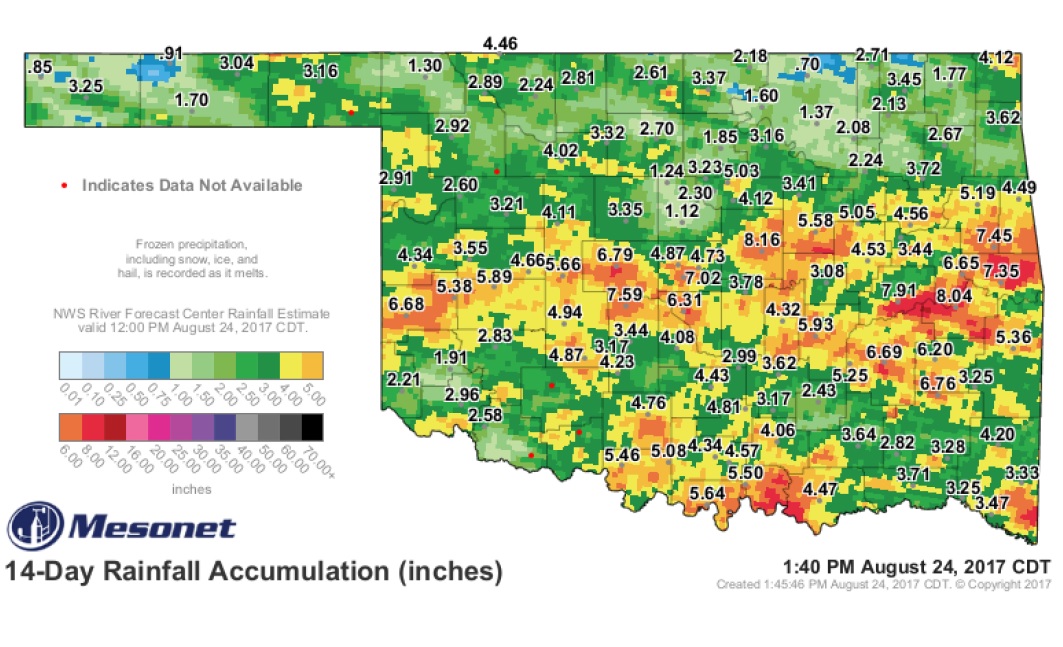
Agricultural News
NASS Crop Production Report Indicates Oklahoma Farmers Planted 470,000 Acres this Year
Fri, 25 Aug 2017 11:05:22 CDT
 The following Crop Update was published during the week of August 24, 2017 by the OSU Southwest Oklahoma Research and Extension Center in Altus, Okla. in the regular Cotton Comments newsletter.
The following Crop Update was published during the week of August 24, 2017 by the OSU Southwest Oklahoma Research and Extension Center in Altus, Okla. in the regular Cotton Comments newsletter.
The August, 2017 USDA-National Agricultural Statistics Service Crop Production Report indicated that Oklahoma planted 470,000 acres and they are anticipating a low abandonment, with 450,000 acres to be harvested. Based on Oklahoma Boll Weevil Eradication Organization data, USDA-Farm Services Agency certified planted acres as of August 3 totaled about 505,000. This number is likely at least around 550,000 based on discussions in the industry. The NASS Report estimated our 2017 all-practices lint yield at 768 lb/acre. This calculates into a total of 720,000 statistical bales. Even with a difficult finish, the crop could still produce over 600,000 bales, which would be roughly equivalent to the 2016 crop. That crop was produced on 295,000 harvested acres, but produced a record yield of 1,021 lb/acre. Beltwide data show that the 2017 US upland planted acreage is just under 12 million, with just under 11 million projected to be harvested. The nearly one million acre abandonment was mostly in Texas. This 2017 US crop is estimated at nearly 20 million bales, which is up about 3.2 million compared to 2016. It appears that the state has the highest planted acreage since 1982, and if we make the projected 720,000 bale production, that would be the most since 1942. We are still a long way from having this crop in the bale. This bale volume will challenge both the harvesting and ginning infrastructure in the state. We need another good fall with warm to hot temperatures to finish a lot of late maturing cotton yield potential. We will also need good harvesting weather. After that, we will be asking a lot out of our gins to get this crop in the bale.
The 2017 crop continues to make good progress. Rainfall over the past two weeks has been substantial over the cotton producing area of the state (Click or tap the link to a PDF of the report, for an accompanying graphic and more information).
This has been a real blessing for the dryland crop. The earliest planted irrigated cotton is getting close to blooming in the terminal. The big agronomic challenge right now is the fact that the high rainfall, which is excellent for driving yield, is also driving vegetative plant growth. Many questions have recently been asked concerning late season mepiquat chloride plant growth regulator (PGR) use. Generally, to get the most vegetative growth control, we need to start early with PGR applications - at match head square, especially with the high yielding, but growthy varieties. Some areas have had so much rain during August that producers have been scrambling to react to the additional growth spurt. Even fields with an excellent preplanned PGR management regime starting at match head square have been challenged by excessive growth this year. Mepiquat chloride PGRs are labeled for cutout applications (Nodes Above White Flower or NAWF = 4 to 6), and high rates can be used. Note that the maximum labeled rate for 0.35 lb/gallon mepiquat chloride products is 24 oz/acre. Some fields with extremely vigorous growing conditions (high growth potential varieties, high nitrogen availability, and excellent moisture) may not respond well, even to high PGR rates. We are past the point of concern of negative impacts due to high rates, as any pinhead square in the terminal has minimal chance of making a fluffy boll at harvest. Based on historical bloom tag data at Altus, the August 25th date for a white bloom will typically result in a good, fluffy open boll at harvest. White blooms occurring after that date get risky, and become heavily dependent upon a stellar September and October heat unit accumulation. We have been blessed by those conditions in the past three years. There is no doubt that many fields will be a challenge to stripper harvest. Fields with large plants and high yields (greater than 2.5 bales/acre with good maturity) should be considered for the spindle picker harvesting method if these machines are available. Many early June planted dryland fields that have received good to excellent rainfall are still "hovering" around 6 to 7 NAWF. This all means that we are going to have a high yield potential in many dryland fields, and some of that will be pushed into the "high risk" category.
Source - OSU Southwest Oklahoma Research and Extension Center
01032_Cotton_Comments_Volume_7_edition_11_August_24_2017.pdf
WebReadyTM Powered by WireReady® NSI
Top Agricultural News
More Headlines...





